How To Grow Pumpkins: No Autumnal Vegetable Patch Would Be Complete Without Them

FRUIT > PUMPKIN
Chris is a gardening writer and nature enthusiast. He graduated from Oxford Brookes University in 2022 with an MA in Psychology. Chris works with the Leeds Green Action Society, helping their food cooperative by growing various fruit and vegetables on their two allotments in Hyde Park, Leeds.
Reviewed By DAN ORI

Dan has over 27 years’ under his belt caring for plants and gardens. Working as a Horticultural Instructor and Consultant, he draws on a diverse range of experience that includes working as a Head Gardener, Tree Surgeon, Garden Centre Trouble Shooter, and writer of academic papers. Dan has a Level 3 Diploma in Horticulture and is currently a candidate for the RHS’s most prestigious award – The Master of Horticulture.
Contributions From SHANNON KEARY

Shannon Keary is a garden blogger who has her own podcast, The Diary of a Lady Gardener, about her experiences with growing in her allotment. She is currently one of the founders of the Mini Gardeners Club, an association aimed at encouraging young children to take up horticulture. Shannon also runs her own small-scale cut flower farm in Devon.
IN THIS GUIDE
PUMPKIN GUIDES
These days more and more gardeners have taken to growing their own produce, reaping the benefits of homegrown fruit and veggies.
And let’s face it: no autumnal vegetable patch would be complete without a pumpkin or two.
Pumpkins are super easy to grow, and once harvested, it’s easy to make use of the entire fruit (yes, pumpkins are fruits!).
The flesh can be used in curries and stews or pureed to use in desserts.

The toasted seeds can be seasoned with sugar and salt and make for an extremely tasty snack and can also be sprinkled over salads.
Whilst you can’t eat the skin, it can be composted to contribute to your autumn garden.
And, of course, come Halloween you can get carving and make your own ghoulish Jack-o’-lantern.
Overview
| Botanical Name | Cucurbita pepo |
| Common Name(s) | Pumpkin |
| Plant Type | Fruit |
| Native Area | North & Central Americas |
| Hardiness Rating | H1C (mostly) |
| Foliage | Green leaves that are large & lobed |
| Flowers | Yellow, edible, followed by the edible fruit |
| When To Sow | April, May |
| Plant Out | June |
| Harvesting Months | September, October |
Sunlight
Preferred
Full Sun
Exposure
Sheltered
Size
Height
Varies greatly
Spread
Varies greatly
Bloom Time
Summer
Soil
Preferred
Most Soil Types
Moisture
Moisture retentive
pH
Any
As previously mentioned, pumpkins are fruit, with most varieties deep yellow to orange in colouration.
They can be found on all continents apart from Antarctica and are one of the oldest domesticated plants with records showing them to be cultivated as early as 7,500 years ago.1Reilly, L. (2015, October 28). Pumpkin’s surprising origin. BBC Travel. Retrieved March 23, 2023, from https://www.bbc.com/travel/article/20151027-pumpkins-surprising-origin
Almost all pumpkins are edible, and their name originates from the Greek word ‘pepon’ meaning large melon.2Pumpkin History. (n.d.). University of Illinois Extension. Retrieved March 23, 2023, from https://web.extension.illinois.edu/pumpkins/history.cfm
Pumpkin Types
While you are probably familiar with the classic orange pumpkins, there are actually over forty varieties of pumpkins, ranging in size, texture and colour.
“Pumpkins are such fun to grow and I’ve found them relatively stress-free, although I always forget to label things properly so don’t ask me what varieties I’m growing!” says Shannon Keary, Garden Blogger & Podcaster.
Their shelf life also differs, making some better for display purposes than others.
‘Atlantic Giant’

If it’s size you’re after, then the Atlantic giant pumpkin is just the ticket.
This variety is one of the world’s largest pumpkin and can weigh up to 180kg (400lbs).3Estadt, M. (n.d.). Growing Giant Pumpkins in the Home Garden. Ohio State University Extension. Retrieved March 23, 2023, from https://ohioline.osu.edu/factsheet/hyg-1646
When Cinderella went to the ball, it was most likely this type of pumpkin that became her magical carriage!
Its skin is bright orange and rough in texture.
Atlantic giant pumpkins are perfect for local pumpkin competitions but, while they are edible, they have little flavour.
That said, they do make an exciting addition to any garden, providing you have the space and can be composted once they begin to decay.
‘Long Island Cheese’
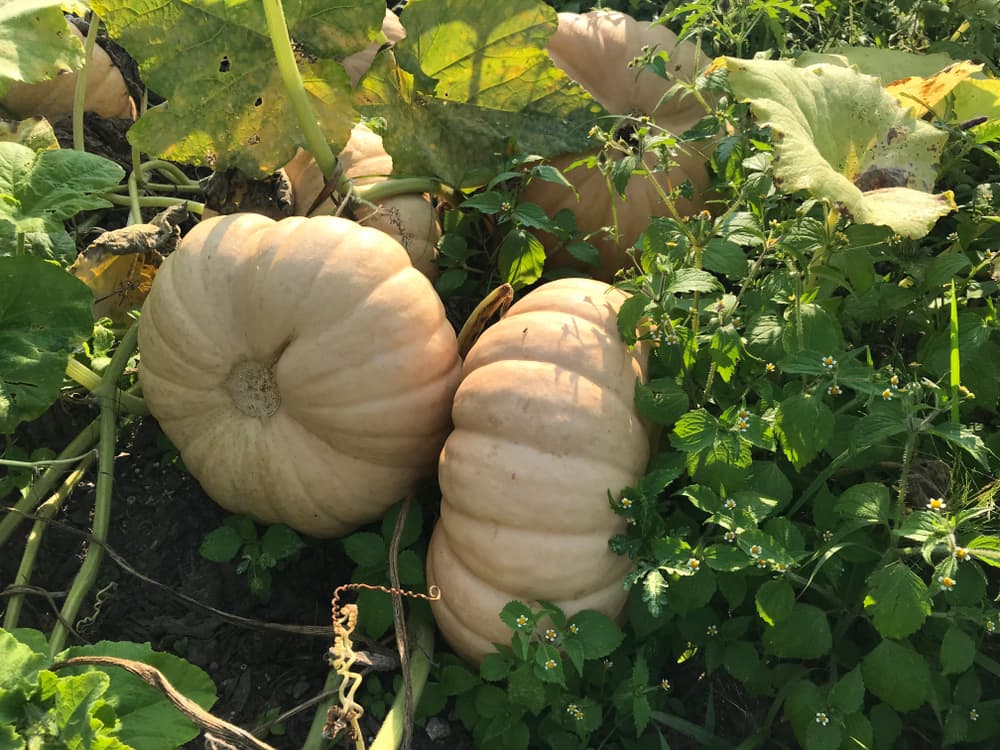
This variety gets its name from an uncanny resemblance to a wheel of cheese.
Thankfully it doesn’t taste like cheese, instead boasting yummy flesh that resembles butternut squash, making it perfect for cooking.
Deep orange in colour and averaging at a weight of around 4.5kg (10lbs), this variety also makes for a wonderful display piece for harvest celebrations and Halloween.
‘Queensland Blue’

As the name would suggest, these pretty pumpkins come in a beautiful blue colour.
Hailing from Australia and growing to a weight of between 3-4kg (6-10lbs) in around 100 days, this variety has a tasty, treacle-like flavour, making it an excellent ingredient for desserts and pies.
If you want your pumpkins to stand out in a crowd, then this unusual variety will do just that and will make your vegetable patch truly pop!
‘Baby Boo’
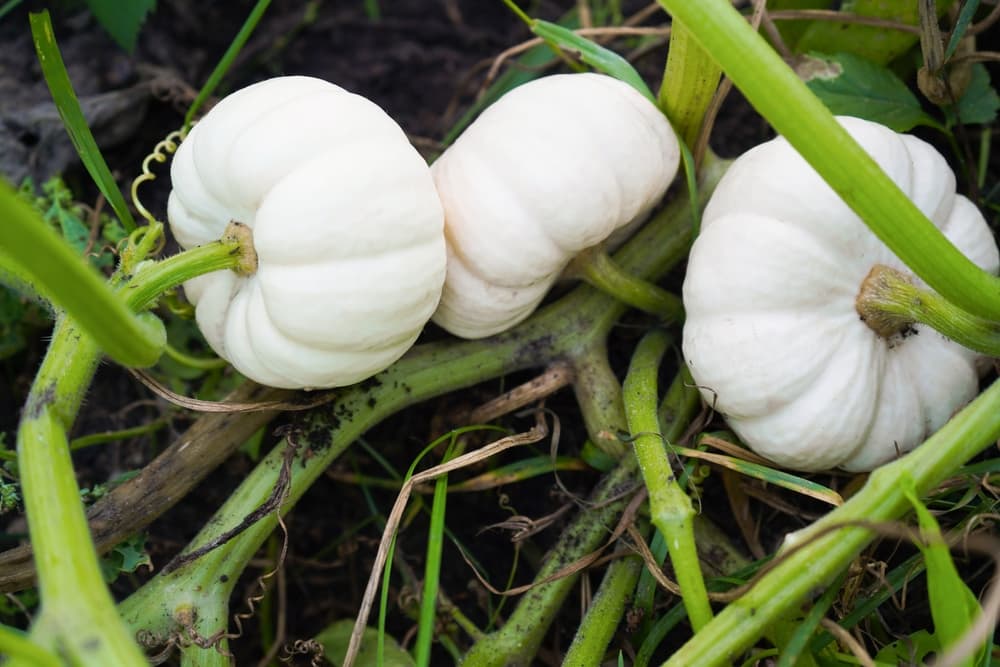
Whilst we’re on the topic of unusually coloured pumpkins, the baby boo variety can’t go without a mention.
This palm-sized, pure white specimen grows no bigger than a tennis ball and takes around 90 days to develop.
Once fully grown, these ghostly baby boo pumpkins should be picked promptly to avoid discolouration.
This type of pumpkin is not edible and is too small to carve so, after harvest, it is really only useful for decorative purposes.
But, mixed in with a display of orange pumpkins, it can make a real statement.
“I love growing mini pumpkins like ‘Jack Be Little’ and ‘Baby Boo’ over an archway,” shares Emma Bailey, a Garden Blogger.
“It always looks so magical and impressive and really doesn’t take that much work! Smaller varieties of pumpkin love to climb, so growing them vertically is a great way to save space.
“In terms of helping them to climb, you can start to tie them in with some twine but once they are established they will happily cling onto your structure themselves!”
How To Grow Pumpkins
Once you’ve decided on your pumpkin of choice, it’s time to get to business.
While the time it takes for them to reach maturity may differ, all pumpkins require the same growth and care regimen.
Sowing Indoors
Sowing pumpkins indoors is quick and easy, and you can get to work anytime between April and June.
Simply fill a 7.5cm pot with compost and place the seed on its side at a depth of around 2.5cm.
Once sown, water and place on a windowsill.
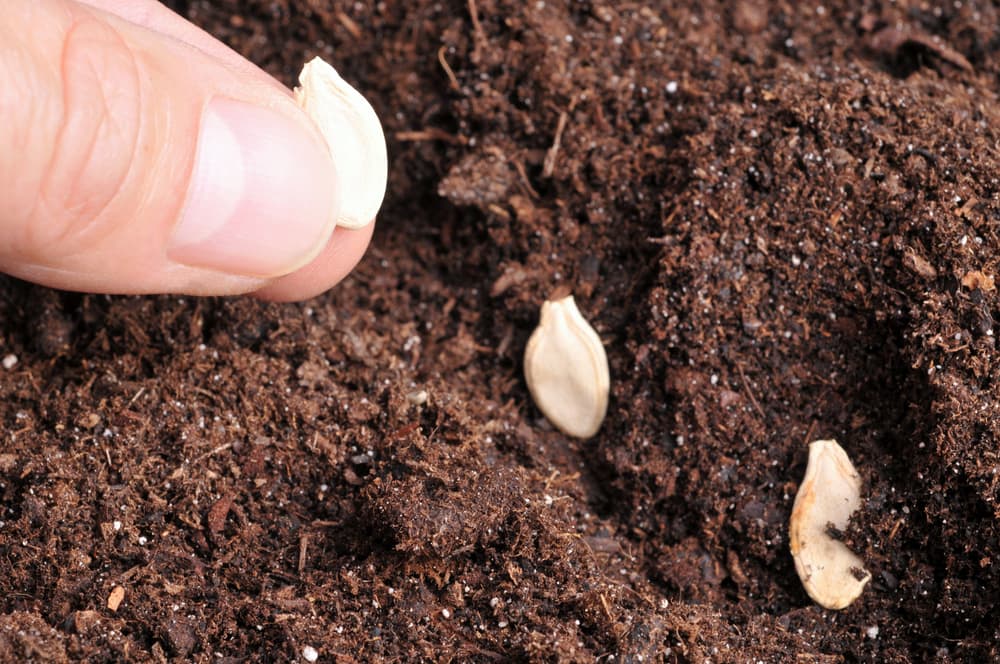
When the roots start appearing through the pot’s bottom, you can transfer your little plant to a 12.5cm pot.
Once the seedlings have established, you can then plant them outside.
Space them at least 2m apart so they have plenty of room to grow – and be sure to pick a sunny, sheltered spot to ensure they thrive.
“Pumpkin seeds germinate easily, although best sown on their thin edge, I have found almost all seeds sown will come up regardless of how they a placed in compost or soil,” shares Horticultural Consultant Dan Ori.
Sowing Outdoors
Whilst sowing pumpkins is best done indoors, if you have a sheltered spot available in your garden, you can sow them outdoors a little later in the year.
Planting pumpkin seeds outside should be done in late May or early June.
Dig a hole of around 3cm in depth and place three seeds in the hole on their sides – you should then cover the area with plastic sheeting or jars for at least two weeks.
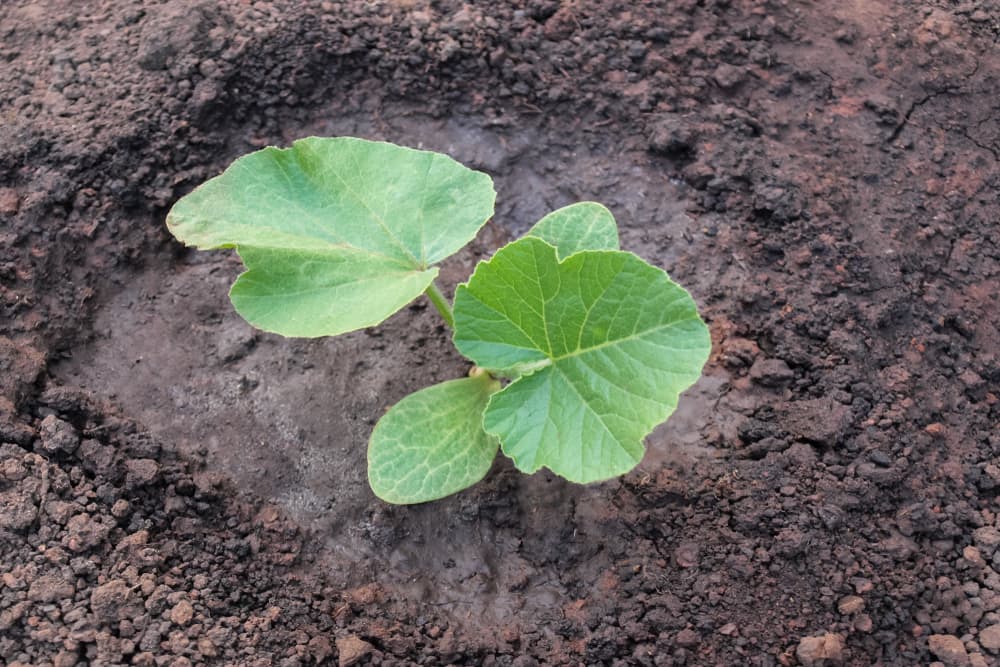
Once the seeds have germinated, remove the weakest seedlings so that only the strongest remain.
“They need nutrient-rich soil, so dig in some manure before planting,” shares Emma.
“Pumpkins are hungry plants, so lots of water and regular liquid seaweed feeds are essential for healthy growth.”
Helpful hint: If you don’t want to start from scratch, most garden centres sell young pumpkin plants to help get you started.
Pumpkin Plant Care
Pumpkins are hardy crops and will flourish almost anywhere with the right care.
Soil Requirements
To achieve the best results, make sure they are planted in moisture-retentive soil, protect the seedlings with mulch and feed with a general fertiliser or tomato plant food.
“Pumpkins are super hungry, so I’ve started digging large tubs with holes in the bottom near the plants and creating my own mini composts heaps which feed the plants as it decomposes,” shares Shannon.
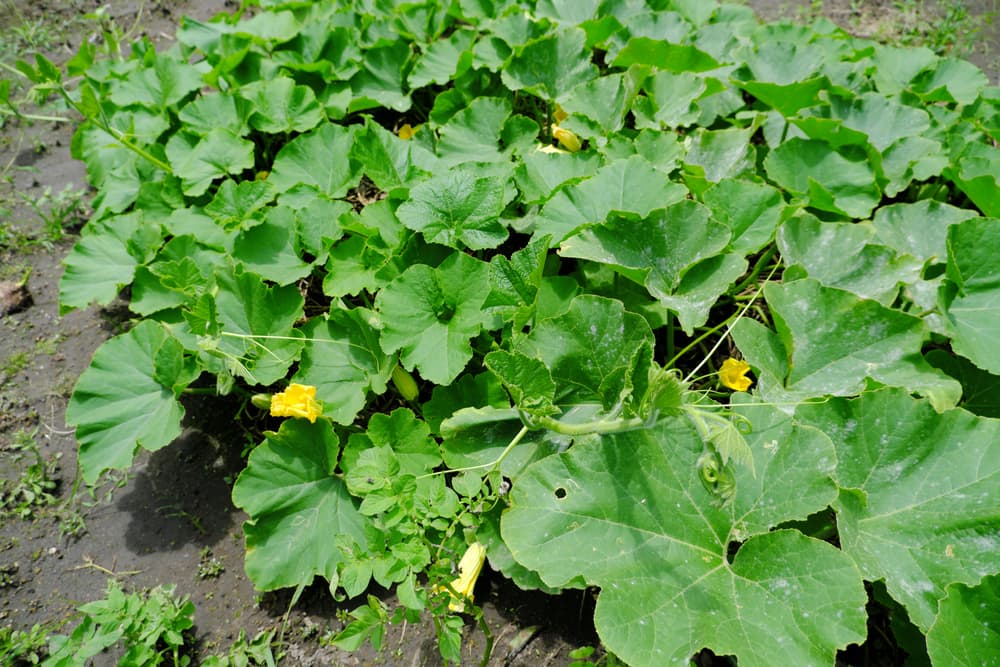
“I’ve also used old milk bottles with small holes planted out about 20cm beneath the soil to ensure that the water goes directly to the roots this year.
“With the hot weather, having this makes it so much easier and less wasteful to water.”
If you’ve opted for a larger variety of pumpkin, train the shoots using wire to help them grow.
If you find you have a number of fruits on the plant, remove a few of them before they develop, this will help the plant focus its energy on the remaining pumpkins resulting in much bigger specimens.
Preventing Rot
One of the most important factors when it comes to growing pumpkins is to prevent them from rotting as they grow larger.
To avoid rot, place the pumpkins on a plank of wood or a few bricks – this will protect them from moisture sitting on the ground and allow them to reach their maximum size.
I would also recommend removing any leaves that cover the pumpkin fruits so they can access as much light as possible – I find this helps them to mature.
“I like to grow my pumpkins through a strong trellis laid flat and elevated above the ground by some bricks,” Dan adds.
“The plant grows through the trellis, it is easy to water and the pumpkin sits on the trellis rather than the ground, helping to prevent rot.”
Common Problems
Pumpkins are rather resilient so you will rarely run into problems with them – the main thing to watch out for is powdery mildew.

Powdery mildew presents itself with a white, powdery deposit on the leaves and, if left unattended, will cause the leaves to wilt.
Thankfully the solution is simple: keep the soil moist around the plants (being careful to avoid wetting the leaves of the plant) and you shouldn’t run into this issue.
“Don’t be afraid to remove a few leaves if you think it will increase airflow, as this will also help reduce mildew and potential rots,” says Dan.
Harvesting & Storage
Pumpkins are brilliant at letting you know when it’s time to harvest them.
Leave them on their stem as long as possible, once ripe their skin will harden, and they will crack away from their stems, letting you know they are good to go!
Pumpkins can be stored for up to six months, just take care to keep them in a cool, well-ventilated space.
“Some of the more popular varieties for Halloween lanterns can rot quickly if left in a warm kitchen, so don’t bring them in too soon if you want to avoid an early horror show,” Dan shares.
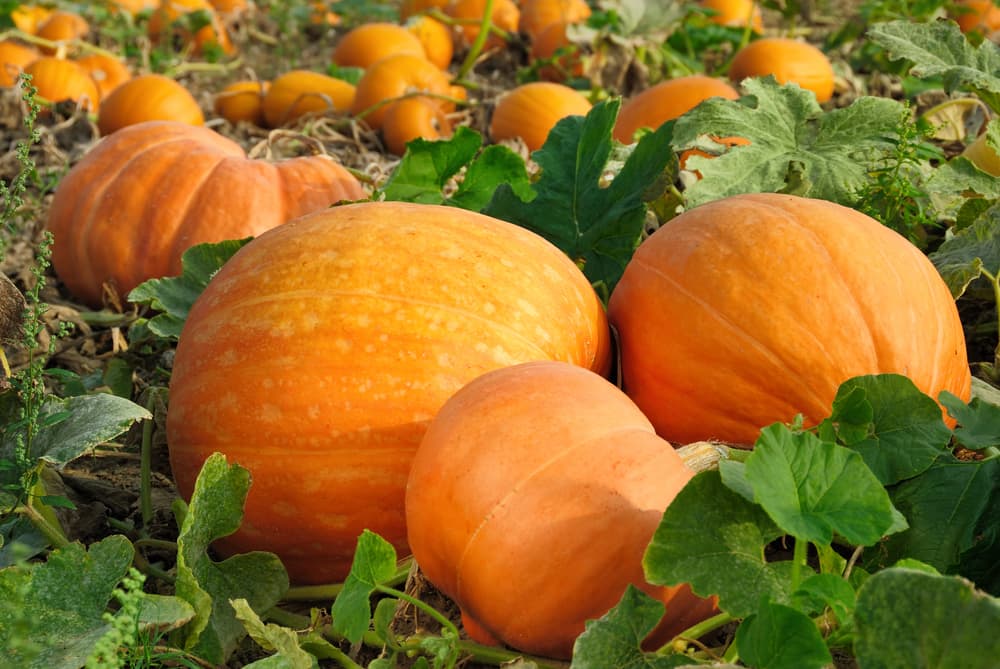
With so many varieties to choose from, you will have no trouble finding the perfect pumpkins for you.
References
- 1Reilly, L. (2015, October 28). Pumpkin’s surprising origin. BBC Travel. Retrieved March 23, 2023, from https://www.bbc.com/travel/article/20151027-pumpkins-surprising-origin
- 2Pumpkin History. (n.d.). University of Illinois Extension. Retrieved March 23, 2023, from https://web.extension.illinois.edu/pumpkins/history.cfm
- 3Estadt, M. (n.d.). Growing Giant Pumpkins in the Home Garden. Ohio State University Extension. Retrieved March 23, 2023, from https://ohioline.osu.edu/factsheet/hyg-1646

